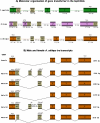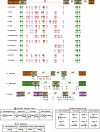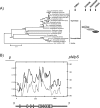The gene transformer of anastrepha fruit flies (Diptera, tephritidae) and its evolution in insects
- PMID: 18043746
- PMCID: PMC2080774
- DOI: 10.1371/journal.pone.0001239
The gene transformer of anastrepha fruit flies (Diptera, tephritidae) and its evolution in insects
Abstract
In the tephritids Ceratitis capitata and Bactrocera oleae, the gene transformer acts as the memory device for sex determination, via an auto-regulatory function; and functional Tra protein is produced only in females. This paper investigates the evolution of the gene tra, which was characterised in twelve tephritid species belonging to the less extensively analysed genus Anastrepha. Our study provided the following major conclusions. Firstly, the memory device mechanism used by this gene in sex determination in tephritids likely existed in the common ancestor of the Ceratitis, Bactrocera and Anastrepha phylogenetic lineages. This mechanism would represent the ancestral state with respect to the extant cascade seen in the more evolved Drosophila lineage. Secondly, Transformer2-specific binding intronic splicing silencer sites were found in the splicing regulatory region of transformer but not in doublesex pre-mRNAs in these tephritids. Thus, these sites probably provide the discriminating feature for the putative dual splicing activity of the Tra-Tra2 complex in tephritids. It acts as a splicing activator in dsx pre-mRNA splicing (its binding to the female-specific exon promotes the inclusion of this exon into the mature mRNA), and as a splicing inhibitor in tra pre-mRNA splicing (its binding to the male-specific exons prevents the inclusion of these exons into the mature mRNA). Further, a highly conserved region was found in the specific amino-terminal region of the tephritid Tra protein that might be involved in Tra auto-regulatory function and hence in its repressive splicing behaviour. Finally, the Tra proteins conserved the SR dipeptides, which are essential for Tra functionality.
Conflict of interest statement
Figures






Similar articles
-
The gene transformer-2 of Anastrepha fruit flies (Diptera, Tephritidae) and its evolution in insects.BMC Evol Biol. 2010 May 13;10:140. doi: 10.1186/1471-2148-10-140. BMC Evol Biol. 2010. PMID: 20465812 Free PMC article.
-
Effect of the gene transformer of Anastrepha on the somatic sexual development of Drosophila.Int J Dev Biol. 2010;54(4):627-33. doi: 10.1387/ijdb.092917fr. Int J Dev Biol. 2010. PMID: 20209435
-
The transformer-2 and fruitless characterisation with developmental expression profiles of sex-determining genes in Bactrocera dorsalis and B. correcta.Sci Rep. 2020 Oct 21;10(1):17938. doi: 10.1038/s41598-020-74856-6. Sci Rep. 2020. PMID: 33087807 Free PMC article.
-
Masters change, slaves remain.Bioessays. 2003 Jan;25(1):1-4. doi: 10.1002/bies.10207. Bioessays. 2003. PMID: 12508274 Review.
-
The Sex Determination Cascade in the Silkworm.Genes (Basel). 2021 Feb 23;12(2):315. doi: 10.3390/genes12020315. Genes (Basel). 2021. PMID: 33672402 Free PMC article. Review.
Cited by
-
Molecular characterization of the key switch F provides a basis for understanding the rapid divergence of the sex-determining pathway in the housefly.Genetics. 2010 Jan;184(1):155-70. doi: 10.1534/genetics.109.109249. Epub 2009 Oct 19. Genetics. 2010. PMID: 19841093 Free PMC article.
-
Patterns and mechanisms of evolutionary transitions between genetic sex-determining systems.Cold Spring Harb Perspect Biol. 2014 Jul 3;6(8):a017681. doi: 10.1101/cshperspect.a017681. Cold Spring Harb Perspect Biol. 2014. PMID: 24993578 Free PMC article. Review.
-
Evaluation of Peregrinus maidis transformer-2 as a target for CRISPR-based control.PLoS One. 2024 Apr 18;19(4):e0295335. doi: 10.1371/journal.pone.0295335. eCollection 2024. PLoS One. 2024. PMID: 38635824 Free PMC article.
-
The transformer gene of Ceratitis capitata: a paradigm for a conserved epigenetic master regulator of sex determination in insects.Genetica. 2011 Jan;139(1):99-111. doi: 10.1007/s10709-010-9503-7. Epub 2010 Oct 2. Genetica. 2011. PMID: 20890720
-
Isolation and Molecular Characterization of the Transformer Gene From Bactrocera cucurbitae (Diptera: Tephritidae).J Insect Sci. 2017 Jan 1;17(2):64. doi: 10.1093/jisesa/iex031. J Insect Sci. 2017. PMID: 28931159 Free PMC article.
References
-
- Sánchez L, Gorfinkiel N, Guerrero I. Sex determination and the development of the genital disc. In: Gilbert LI, Iatrou K, Gill SS, editors. Comprehensive Molecular Insect Science, Vol. 1. Oxford, UK: Elsevier Pergamon; 2005. pp. 1–38.
-
- Bell LR, Horabin JI, Schedl P, Cline TW. Positive autoregulation of Sex-lethal by alternative splicing maintains the female determined state in Drosophila. Cell. 1991;65:229–239. - PubMed
-
- Boggs RT, Gregor P, Idriss S, Belote JM, McKeown M. Regulation of sexual differntiation in Drosophila melanogaster via alternative splicing of RNA from the transformer gene. Cell. 1987;50:739–747. - PubMed
-
- McKeown M, Belote JM, Baker BS. A molecular analysis of transformer, a gene in Drosophila melanogaster that controls female sexual differentiation. Cell. 1987;48:489–499. - PubMed
Publication types
MeSH terms
LinkOut - more resources
Full Text Sources
Molecular Biology Databases
Research Materials

